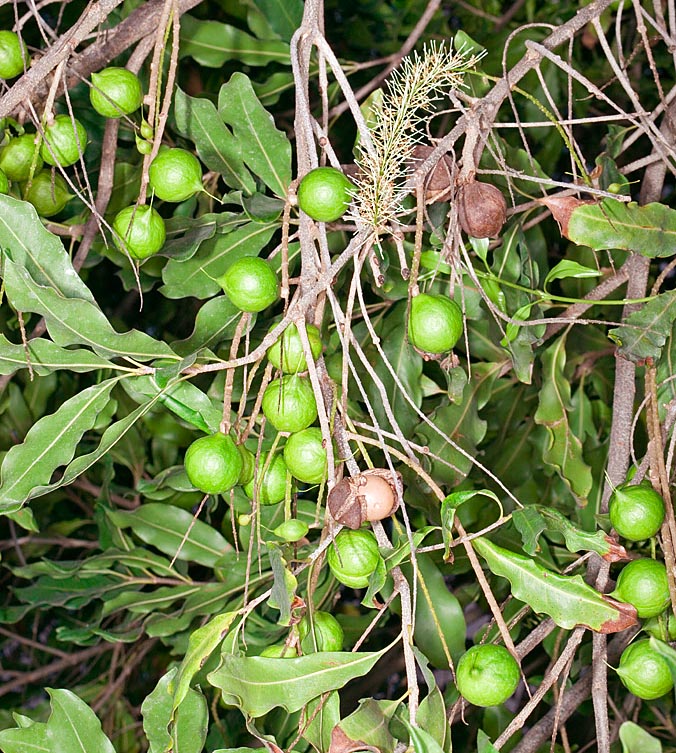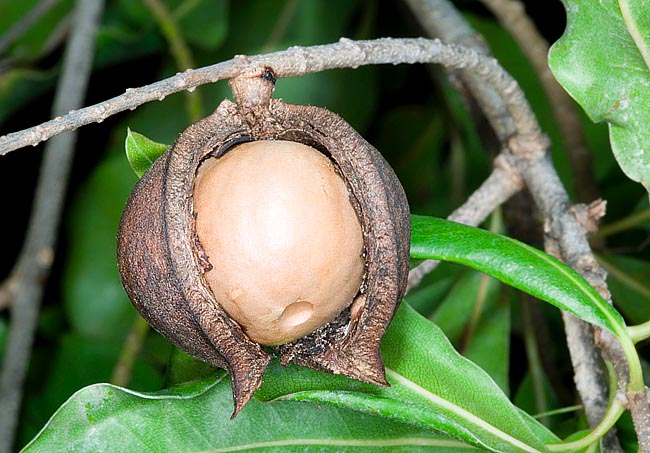Family : Proteaceae

Text © Pietro Puccio

English translation by Mario Beltramini

Macadamia integrifolia close-up with one inflorescence, growing and ripe fruits © Giuseppe Mazza
The genus is honoured to the Australian physician, chemist and politician, Scottish-born, John Macadam (1827-1865); the name of the species is the combination of the Latin adjective “integer, -gra, -grum” = entire and of the substantive “folium” = leaf, with reference to the entire margins.
Common names: bopplenut, bushnut, macadamia nut, Queenslandnut, smooth-shelled macadamia, smooth-shelled Queensland-nut (English); ao zhou jian guo (Chinese); macadamia à coque lisse, macadamier, noisetier d’Australie, noix de macadamia, noix du Queensland, noyer du Queensland (French); macadamia, noce del Queensland, noce di macadamia (Italian); macadâmia, nogueira-do-havaí, nogueira-macadâmia, noz de macadâmia (Portuguese); avellano de Australia, macadamia, nuez austra- liana, nuez de macadamia (Spanish); Echte Macadamianuß, Glattschalige Macadamia, Macadamianuß (German).
The Macadamia integrifolia Maiden & Betche (1896) is a very ramified evergreen tree, 5-18 m tall, with coriaceous simple leaves, on a 0,5-1,5 cm long petiole, usually arranged in verticils of three, oblong to oblanceolate, 8-20 cm long and 2-6 cm broad, with margin entire or irregularly provided of thorns and acuminate or obtuse apex, of glossy dark green colour. Simple axillar inflorescences, hanging, 8-25 cm long, carrying 100 to 300 perfumed hermaphrodite flowers with 0,5-1,2 cm long, white or cream perianth, pollinated by insects.
The fruits are globose drupes of 2-3,5 cm of diameter with fleshy and fibrous green mesocarp, often opening when ripe, and woody endocarp particularly hard, of glossy brown colour, usually containing only one globose seed, of 1,2-2,5 cm of diameter, commonly called macadamia nut, which is the edible part.
It reproduces by seed, previously kept in water for 24 hours, in sandy loam rich of organic substance kept humid at the temperature of 22-25 °C, which germinates in 1-2 months and takes 7-12 years for starting the production, but the quality is not predictable; in order to conserve a certain variety and shorten the times of entrance in production recourse is done to the grafting on about one year old plants, with the first flowering after 2-3 years, and to the air layering. It easily hybridizes with Macadamia tetraphylla.

Open ripe fruit with the woody endocarp containing one edible seed of 1,2-2,5 cm © Giuseppe Mazza
It requires a position in full sun, aerated, but sheltered from strong winds, being the branches rather frail, and is not particular about the soil provided the same is deep, well drained and rich of organic substance, slightly acidic or neutral.
The flowers are subject to fungal attacks, in particular by Botrytis cinerea, in situations of high humidity and poor ventilation, and the rooting apparatus to rottenness by various pathogens, the most common by Phytophthora cinnamomi, in situations of poor drainage and prolonged water stagnations. The fruits are perfectly ripe when they fall from the tree, they are therefore to be usually collected manually, which is one of the reasons of the high cost of the product, and they are to be mechanically deprived, within 24 hours from the collection, of the mesocarp, which is recycled in the plantation, then sent to the drying plants, fundamental process because it causes the separation of the seed from the shell, avoiding its damaging at the moment of the breakage, and improves its organoleptic characteristics; particular devices have been realized for breaking the very hard shell.
Most of the macadamia nuts produced commercially come from selected varieties of Macadamia integrifolia and from its hybrids with Macadamia tetraphylla, more resistant than the first, but which gives a product of slightly inferior quality. The nuts contain the 72-75% of oil, of which more than the 77% is formed by monounsaturated fats, and about the 8% by proteins, besides minerals and vitamins, they are consumed raw or roasted, or used ground for preparing various dishes and confectionary products, the oil is utilized for cooking and in the soap industry and in the cosmetics one. Finally, we must not undervalue the ornamental characteristics of the tree, often utilized in parks and gardens in the tropical and subtropical zones for the foliage and the decorative, perfumed inflorescences.
